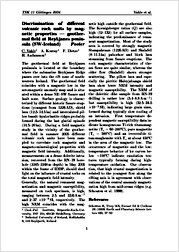| dc.contributor.author | Vahle, C. | |
| dc.contributor.author | Kontny, A. | |
| dc.contributor.author | Dietze, F. | |
| dc.contributor.author | Audunsson, H. | |
| dc.contributor.editor | Philipp, Sonja | |
| dc.contributor.editor | Leiss, Bernd | |
| dc.contributor.editor | Vollbrecht, Axel | |
| dc.contributor.editor | Tanner, David | |
| dc.contributor.editor | Gudmundsson, Agust | |
| dc.date.accessioned | 2010-11-26T13:21:13Z | |
| dc.date.accessioned | 2013-01-28T10:20:55Z | |
| dc.date.available | 2010-11-26T13:21:13Z | |
| dc.date.available | 2013-01-28T10:20:55Z | |
| dc.date.issued | 2006-03 | |
| dc.identifier.citation | Philipp, S.; Leiss, B; Vollbrecht, A.; Tanner, D.; Gudmundsson, A. (eds.): 11. Symposium "Tektonik, Struktur- und Kristallingeologie"; 2006, Univ.-Verl. Göttingen, p. 238 - 239. | |
| dc.identifier.isbn | 3-938616-40-7 | |
| dc.identifier.uri | http://hdl.handle.net/11858/00-1735-0000-0001-342A-C | |
| dc.description.abstract | The geothermal field at Reykjanes
peninsula is located at the boundary
where the submarine Reykjanes Ridge
passes over into the rift zone of southwestern
Iceland. The geothermal field
coincides with a magnetic low in the
aeromagnetic anomaly map and is situated
within a dense NE–SW fissure and
fault zone. Surface geology is characterized
by different historic fissure eruptions
(youngest from 1226AD), shield
lava (12.5–14.5 ka) and intercalated pillow
basalt–hyaloclastite ridges probably
formed during the last glacial episode
(14.5–20 ka). During a field magnetic
study in the vicinity of the geothermal
field in summer 2005 different
volcanic rock units have been sampled
to correlate rock magnetic and
magneto-mineralogical properties with
magnetic field intensity. Additionally,
measurements on a dense dolerite intrusion,
recovered from the RN–19 borehole
(2245–2248m depth) in May 2005
within the frame of IDDP, should shed
light on the influence of crustal rocks on
the total magnetic field intensity.
Generally, the natural remanent magnetization
and magnetic susceptibility,
measured on rock specimen, is high,
ranging between 2.5 and 33.6Am−1
and 2–37 ×10−3 SI, respectively... | |
| dc.format.mimetype | application/pdf | |
| dc.language.iso | deu | |
| dc.publisher | Universitätsverlag Göttingen | |
| dc.relation.ispartof | 11. Symposium "Tektonik, Struktur- und Kristallingeologie" | |
| dc.subject.ddc | 551 | |
| dc.subject.gok | TOT 320 | |
| dc.subject.gok | TSZ 100 | |
| dc.subject.gok | TSD 000 | |
| dc.subject.gok | TQB 000 | |
| dc.subject.gok | VED 500 | |
| dc.subject.gok | VEZ 110 | |
| dc.subject.gok | VAE 890 | |
| dc.subject.gok | VKA 150 | |
| dc.subject.gok | VKB 326 | |
| dc.title | Discrimination of different volcanic rock units by magnetic properties — geothermal field at Reykjanes peninsula (SW-Iceland) | |
| dc.type | anthologyArticle | |
| dc.subject.gokverbal | Paläomagnetismus {Geophysik} | |
| dc.subject.gokverbal | Atlantischer Ozean {Geophysik} | |
| dc.subject.gokverbal | Nordeuropa {Geophysik} | |
| dc.subject.gokverbal | Erdmagnetische Verfahren {Geophysik} | |
| dc.subject.gokverbal | Island {Geologie} | |
| dc.subject.gokverbal | Teilgebiete {Geologie} | |
| dc.subject.gokverbal | Ozeanische Kruste {Tektonik} | |
| dc.subject.gokverbal | Physikalische Petrologie | |
| dc.subject.gokverbal | Magnetische Stratigraphie {Sedimentologie} | |
| dc.bibliographicCitation.firstPage | 238 | |
| dc.bibliographicCitation.lastPage | 239 | |
| dc.identifier.doi | 10.23689/fidgeo-1915 | |
| dc.type.version | publishedVersion | |
| dc.subject.free | Reykjanes | |
| dc.subject.free | Reykjanesrücken | |
| dc.subject.free | Ergussgestein | |
| dc.subject.free | Magnetische Suszeptibilität | |
| dc.subject.free | Magnetostratigraphie | |
| dc.relation.collection | Geologische Wissenschaften | |
| dc.description.type | conference | |


